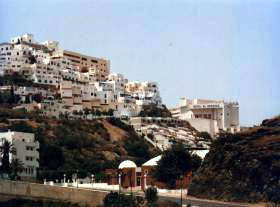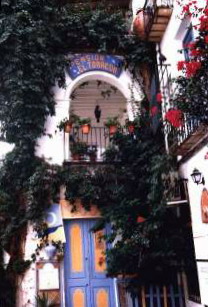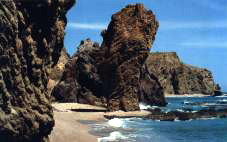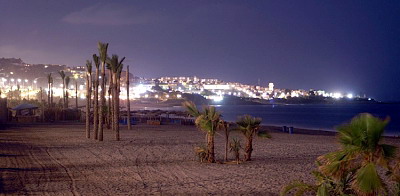Mojacar
Guide:
History
No other corner of Andalucía
can boast such a rich and close heritage with their Moorish past as does
Mojácar. With her exceptional situation as a lookout dominating
the surrounding terrain, Mojácar has been settled by many and varied
peoples since antiquity. Populated since the bronze age around 2000 BC,
soon traders such as Phoenicians and Carthaginians arrived to serve the
growing communities. Under Greek dominion, the settlement was called Murgis-Akra,
from whence came the latinized Moxacar, the Moorish Muxacra and finally
the current name of Mojácar. The north African moors established
themselves in Spain in the early VIII century and the province of Almería
became firstly under the authority of the Caliphate of Damascus and later
on was ruled from Cordoba. Under this second enlightened rule, Mojácar
quickly grew in size and importance. With the coronation of Mohammed 1st
in Granada, Mojácar and its lands became incorporated into the Nazari
sultanate, and the town found itself on the frontier with the Christian
forces to the east. Watchtowers and fortresses were built or re-enforced
during the XIV century, which nevertheless did little to discourage Christian
incursions and fierce battles like the bloody event of 1435 where much
of the population of Mojácar was put to the sword. On June
10th, 1488, the leaders of the region agreed to submit to the Christian
forces, although Mojácar's alcaide refused to attend, considering
his town to be already Spanish. At that time occurred the well-known meeting
at Mojácar's Moorish fountain, where a pact of free association
between the local Moors, Jews and Christians was agreed to. Mojácar
once again began to expand until the early XVIII century, when the census
of the time recorded 10,000 souls. Around the middle of the XIX century,
Mojácar began another period of decline.
 The
records state that several severe droughts brought about this drop in the
town's fortunes, with a consequent emigration to northern Spain, Europe
and South America. The depopulation of Mojácar was reaching worrying
proportions by the 1960's when tourism began to reverse the trend. Today,
Mojácar remains loyal to her past with her architecture, the whitewashed
houses and the openness of her subjects, who inherited the ways of understanding
and sympathy from their forebears. Perhaps one result of this continuous
mixing of cultures and religions is the INDALO - or 'Mojácar man'.
This magical totem brings protection and good luck, and from times past
was always painted onto the fronts of houses once the whitewash was dry:
keeping away the 'evil eye' and protecting those within from storms. The
figure might be interpreted to be a man holding a rainbow between his outstretched
arms. The
records state that several severe droughts brought about this drop in the
town's fortunes, with a consequent emigration to northern Spain, Europe
and South America. The depopulation of Mojácar was reaching worrying
proportions by the 1960's when tourism began to reverse the trend. Today,
Mojácar remains loyal to her past with her architecture, the whitewashed
houses and the openness of her subjects, who inherited the ways of understanding
and sympathy from their forebears. Perhaps one result of this continuous
mixing of cultures and religions is the INDALO - or 'Mojácar man'.
This magical totem brings protection and good luck, and from times past
was always painted onto the fronts of houses once the whitewash was dry:
keeping away the 'evil eye' and protecting those within from storms. The
figure might be interpreted to be a man holding a rainbow between his outstretched
arms.
The original totem is thought
to be around 4,500 years old, and the earliest known one appears among
other prehistoric paintings in a cave in Velez Blanco.
The name, Indalo, is recent,
and was coined by a group of artists and intellectuals who settled in Mojácar
in the early 'sixties, attracted by the magic and bewitchment of the town,
and who commercialised the totem which today signifies the whole province
of Almería.
The Village
The best way to see Mojácar
is to leave the car in the car park and walk to appreciate the pretty medieval
arab arquitecture.
From the Platform of the
Plaza Nueva we have an impressive view of the Valle de las Pirámides.
From this we can see that Mojácar la Vieja, the first prehistoric
settlemet of Mojácar, was built on the side of the river "Aguas"
whose estuary is found on Mojácar beach, this part being a protected
area.
In the square we can find
the Ermita de los Dolores dated from the 18C.
From here we can reach The
Mirador Castillo, the highest point of the Village. It is really worth
spending some time looking at the magnificent view of the Mojácar
Coastline. Back down to the square we take the street called "Alcalde Jacinto"
up to the Church Santa Maria (1560), originally a fortress made of huge
stone slabs, its sober interior open to the public at the usual times of
worship.
In front of the church we
find the marble statue of the Mojaquera, wearing the typical dress, her
face covered in the arab style. She is carrying the water container used
to bring the same from the well. At the side of the church we find a stairway
leading down to the Plaza del Parterre, which was the old arab cementary.
Here is the street "En medio" which follows the old blindary wall that
protected the higher part of the village. We now reach the Town Hall Square,
with its magnificent old tree, brought from the Americas. Walk from here
to the City Door - Puerta de la Almedina is the arab inscription - with
its archway (15C) which shows the coat of arms of Mojácar. At the
side of the archway we find the Casa del Terreón, the old lodge
for paying the taxes to enter the town. Its actual design dates from 18C.
 From
here we arrive in the Plaza de las Flores, into the old Jewish Quarter,
with its labyrinth of tiny streets. We can return to the archway by way
of the streets called Guardia, Puntica, Embajadores with their beautiful
sea views, or take the lower road, Cuesta de la Fuente, a beautiful winding
road to arrive at the old pathway to the Fuente Mora (well) remodelled
and retaining. From
here we arrive in the Plaza de las Flores, into the old Jewish Quarter,
with its labyrinth of tiny streets. We can return to the archway by way
of the streets called Guardia, Puntica, Embajadores with their beautiful
sea views, or take the lower road, Cuesta de la Fuente, a beautiful winding
road to arrive at the old pathway to the Fuente Mora (well) remodelled
and retaining.
La Fuente
Some women can still be found
doing their washing by hand. From the 12 old taps we can drink some refreshing
water. An important part of Mojácar's history is written on the
Monument. From the Fuente, we can catch the local bus, back to Mojácar
or to the beach.
The Beach
From La Marina de la Torre
to Sopalmo and the Granatilla beach, Mojácar's coast is 17 kilometres
of shoreline - from empty coves to bustling beaches.
Marina de la Torre, in front
of a golf course, is around two kilometres of white sandy coastline, removed
from the urban sprawl.
 The
mouth of the River Aguas offers an extended sandy beach which continues
along the coast as La Rumina. The Descargador and Vista de los Angeles
beaches offer quiet sunbathing with some installations and services. El
Cantal is the most popular of all our beaches, with a large variety of
installations, beach bars and the like. Similarly, the Cueva del Lobo and
Ventanicas beaches are popular with visitors, although the sand here is
courser: once again, these are full service beaches. The
mouth of the River Aguas offers an extended sandy beach which continues
along the coast as La Rumina. The Descargador and Vista de los Angeles
beaches offer quiet sunbathing with some installations and services. El
Cantal is the most popular of all our beaches, with a large variety of
installations, beach bars and the like. Similarly, the Cueva del Lobo and
Ventanicas beaches are popular with visitors, although the sand here is
courser: once again, these are full service beaches.
Mojácar has wisely
protected other beaches - including some of the most dramatic ones - from
any development - such as Macenas, Cala del Peñon, Cala del Sombrerico,
Bordenares, El Lance and the final cove of the municipality to the west,
Cala Granatilla.
Nature
Situated in the south eastern
province of Almería, Mojácar enjoys an excellent location:
protected from behind by the Cabrera mountain range and overlooking the
warm Mediterranean sea. This southerly location, the proximity to the Africa
continent and the high surrounding ranges all contribute to keeping any
cloudy fronts away, while the warm Mediterranean assures Mojácar
of an exceptional subtropical climate. Temperatures are kind the year round,
with an average of 21º Celsius. This agreeable climate allows for
an abundance of wild flowers and herbs, such as thyme, lavender and esparto
grass. In the dry river causeways and moister areas we find bamboo, tamarisk
and rosebay. Cultivations of almond, olive, carob, fig and orange trees
intermix with prickly pair, century plants, palms and delightful bouganvillas,
all contributing towards Mojácar's singular charm as well as playing
host to a large variety of birds such as linnets, swifts, green finches,
wood larks, hoopoes, magpies, partridges and so on.
In the wet areas at the mouth
of the River Aguas, flocks of migratory birds can sometimes be observed,
such as herons, flamingos and sandpipers.
Rare and protected fauna
locally include the Greek Tortoise and the Martin.
Common mammals include wild
boar, foxes, rabbits and hares.
Gastronomy
Mojácar offers a rich
variety of regional and international dishes to awaken and delight all
her guests. The traditional fare, born from rural and Moorish skills, continues
strongly. From both the sea and the nearby orchards comes a rich variety
of materials bringing such simple delights as fresh fish on the hot plate,
and such traditional dishes as our stews, soups and savouries. National
and international cuisine is also well represented in our many fine restaurants.
Nightlife
The coming of night is a
special experience. From the setting of the sun over the mountains, delicately
tinting the town in shades of pink and silvering the sea below, Mojácar
captures our souls and brings us out to enjoy the mystical streets of the
town. We are lured into discovering hidden treasures at every turn.

The moon, our host, hovers
over romantic dinners, relaxed conversations and candlelit engagements
while music rooted in Arab traditions mixes gently with more modern interpretations
from a full range on international night spots to appeal to all ages.
Mojácar has a full
range of concerts, exhibitions and shows: framed in exceptional locales
such as her legendary fountain, her charming plazas or along her coastline.
Mojácar's nights have
always held a special thrall - an irresistible attraction that mutates
to our own characters and ages: welcoming us always as an active part of
the magic and cosmopolitan atmosphere.
Mojácar is dressed
for the evening, clad with beautiful jewels, and ready to whisper legends
into our willing ears as she invites us to join her subjects as they flit
from fiesta to fiesta and from one delightful corner to another: gathering
new friends along the way.
Dawn finally overtakes us
with its extraordinary beauty and a new reminder of Mojácar's natural
vitality.
Sport
Graced by her climate, this
corner of Spain's south-east can offer a variety of means of enjoying ourselves
in a natural setting all the year round. We can drop below the surface
of the warm Mediterranean with undersea sports, and it is almost always
calm enough to water-ski above, to go boating, canoeing, fishing, swimming
or sunbathing alongside on the sandy beaches. Stronger sensations can be
enjoyed with ultralite fly-bys, parachuting, jet-skis or a race against
your friends with go-karts.
Hikers get to know our secrets
and natural marvels. For other adventurers, there is the opportunity to
explore by horse riding or on mountain bikes. Certain hotel-run installations
offer tennis and lawn bowls while 10 magnificent golf courses are available
year round for play.
Not far away, we have pot-holing
in a gigantic underground system and several four wheel drive racetracks.
Almeria
Hotels / Mojacar Hotels /
Top
|

